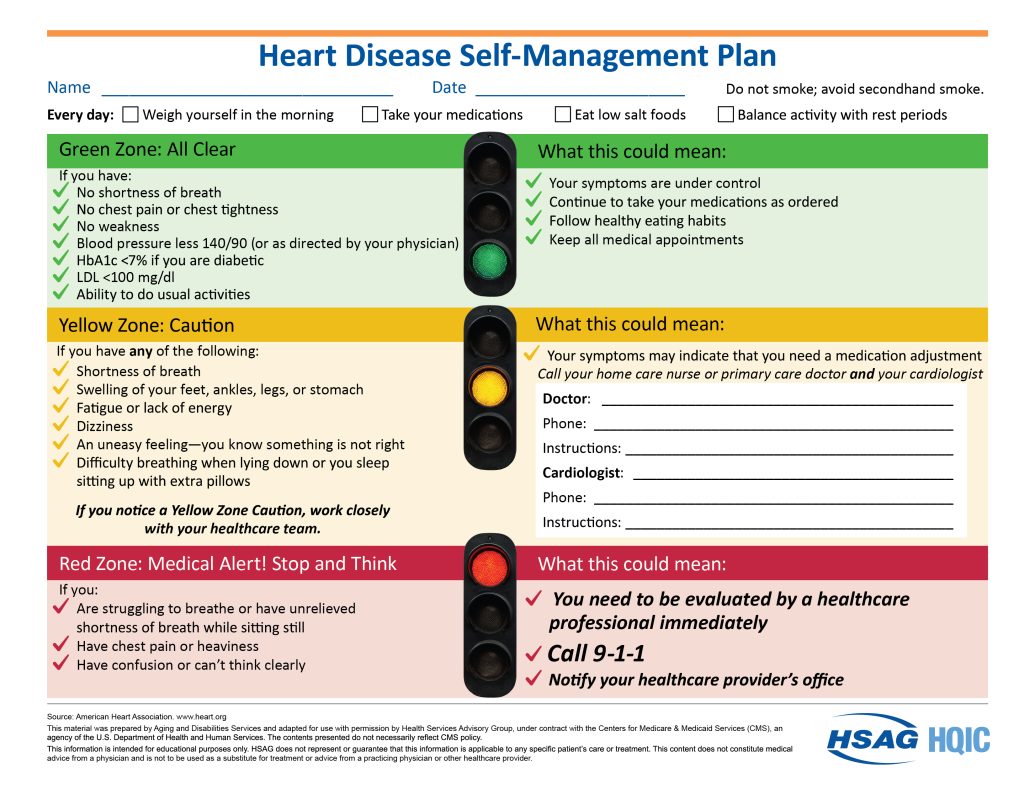Managing heart disease takes teamwork — between you, your caregivers, and your healthcare providers. Small, consistent actions each day can help prevent complications and keep your heart functioning well. This Heart Disease Self-Management Plan uses a simple traffic-light system to help everyone know what to do when symptoms change. Whether you’re a senior living at home, a caregiver, or part of a care team, this tool helps you recognize early warning signs and act quickly to stay safe.

Your Daily Routine (Do this every day)
- Weigh yourself in the morning.
- Take your medications exactly as prescribed.
- Eat low-salt foods; limit processed/packaged items.
- Balance activity with rest periods.
- Do not smoke and avoid secondhand smoke.
Green Zone — All Clear
How you feel
- No shortness of breath.
- No chest pain or chest tightness.
- No unusual weakness.
- Blood pressure is < 140/90 (or as your clinician directs).
- If you have diabetes, HbA1c < 7%.
- LDL < 100 mg/dL.
- Able to do your usual activities.
What it means / What to do
- Your symptoms are under control.
- Keep taking medications as ordered.
- Continue heart-healthy eating.
- Keep all medical and therapy appointments.
Yellow Zone — Caution
Call your home-care nurse or primary care doctor and your cardiologist if you notice any of the following:
- Shortness of breath.
- Swelling in feet, ankles, legs, or stomach.
- Fatigue or low energy.
- Dizziness.
- An uneasy feeling that “something isn’t right.”
- Trouble breathing when lying down, or needing extra pillows to sleep.
What it may mean
- You might need a medication review or adjustment.
Be ready with this information
- Doctor (name & phone): ______________________________
- Instructions from the team: ___________________________
- Cardiologist (name & phone): _________________________
- Instructions from the team: ___________________________
Red Zone — Medical Alert: Stop and Think
If you have any of the following, act now:
- Struggling to breathe or shortness of breath even while sitting still.
- Chest pain or a heavy/pressure sensation.
- New confusion or trouble thinking clearly.
What to do
- You need immediate evaluation by a healthcare professional.
- Call 9-1-1 right away.
- Notify your healthcare provider’s office after calling 9-1-1.
Tips to Make This Plan Work
- Keep this guide on the fridge or by the scale.
- Track morning weights, blood pressure, symptoms, and meds in a notebook or phone app.
- Share updates with your nurse/doctor/cardiologist at every visit.
- Caregivers: note changes from the Green list to the Yellow list and call early—before symptoms worsen.
Disclaimer
This article is for education, not a diagnosis or treatment plan. Always follow your clinician’s instructions and local emergency guidance. If you think you’re having an emergency, call 9-1-1.
Source
Adapted from the American Heart Association. www.heart.org.
This material was prepared by Aging and Disabilities Services and adapted for use by the Health Services Advisory Group (HSAG) under contract with the Centers for Medicare & Medicaid Services (CMS), U.S. Department of Health and Human Services.
- The HOPE Note: Transforming Primary Care with Integrative Health
- Essential Guide to LGBT Caregiving: Challenges, Steps & Resources
- Carrying on a Legacy of Love: The “Bread Run” with Sister Joyce and The Crew
- Stop the Bite: Bedbug Detection, Prevention, and Treatment
- Common Warning Signs of Mental Health: A Guide for Families and Caregivers


